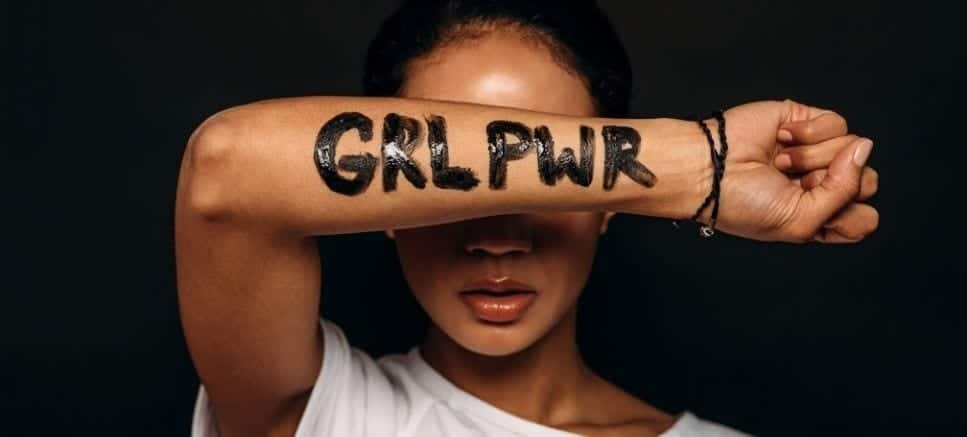Home > Lifestyle > Empowerment > International Women’s Day: Sisters are doing it for themselves…


This Monday was International Women’s Day and so to continue the celebration of women this week we’re looking at some of the kick-ass, strong women throughout history who have proved that sisters really can do it for themselves!
Perhaps the earliest example of a strong woman is Cleopatra who ruled Ancient Egypt from 51BC until her death in 30BC. Although Cleopatra ruled alongside her two brothers and her son, she alone was responsible for influencing Roman politics.
During her reign, Egypt was under the command of the Roman Empire. Cleopatra has become infamous as the first and perhaps ultimate femme fatale by having an affair with Julius Caesar and then his friend, statesman, and Roman General, Mark Anthony, with whom she had three children.
Whether she really did bathe in milk or indeed died from the bite of an asp, we’ll never know. But her legacy will live on as one of the most powerful, beautiful and enigmatic women from the ancient world.
The Maid of Orleans was just 19 years old when she was burned at the stake. However, by that time, she had earned herself a place in the history books as a French heroine during the latter stages of the Hundred Years’ War with England.
According to the history books, she began hearing voices, reportedly of saints, who told her to drive the English out of France and get the Dauphin to Rheims to be crowned King.
But, as historian Stephen W. Richey points out in his book ‘Joan of Arc: A Military Appreciation’: “Only a regime in the final straits of desperation would pay any heed to an illiterate farm girl who said that the voice of God was instructing her to take charge of her country’s army and lead it to victory.”
It was at Orleans, however, that Joan did indeed help the French beat the English. Apparently, though, she did not actually do any fighting or kill anyone. She accompanied the men as an inspirational mascot but was mainly responsible for strategy, directing the troops and proposing diplomatic solutions.
She was captured by the English two years after the triumph at Orleans and put on trial. Of the 70 or so charges brought against her, there were only 12 that were pursued. Mainly that of cross-dressing and saying she heard God’s voice.
Thanks to a biased and politically motivated trial, Joan was executed in 1431. A posthumous retrial that began in 1452, finally declared her innocent in 1456. She was eventually canonized in 1920.
The first female leader in history to have an entire ‘age’ named after her. As the daughter of one of history’s trailblazing kings, Henry VIII, it’s little wonder that Elizabeth had the temerity to bring a broken kingdom together, restore stability and help England become a powerful player in Europe in both politics, trade and the arts.
The Virgin Queen ruled by good counsel, and during her reign oversaw the defeat of the Spanish Armada. This was no mean feat considering the patriarchal world she inhabited where women were thought to be unfit to rule temperamentally, intellectually and morally. Although she had a loyal group of trusted advisors, the queen’s word was the final word.
She was the ultimate in girl power.
As the original feminist, Mary was a passionate campaigner for equality for women, both educationally and socially.
Her most famous work is the feminist classic ‘A Vindication of the Rights of Woman’ published in 1792, which “challenges the notion that women exist only to please men”. She proposed that “women and men be given equal opportunities in education, work, and politics”.
She led an unorthodox lifestyle and had two known affairs before she married William Godwin, who is considered the first advocate of anarchism. Her affair with Gilbert Imlay, an American author, diplomat and businessman, produced a daughter, Fanny. She had a daughter with Godwin but died from complications eleven days after giving birth. That daughter grew up to be another strong woman, Mary Shelley.
The novelist Bertha von Suttner was the first woman to be awarded to Nobel Peace Prize in 1905. She was awarded the honour for her audacity to oppose the horrors of war in her 1889 book ‘Lay down your arms’, which is considered one of the most influential novels of the nineteenth century.
It was this book that cemented her status as one of the leading figures in the Austrian peace movement.
Tolstoy compared her to American abolitionist and author Harriet Beecher Stowe, saying that both ladies used entertainment for idealistic purposes. For Suttner, in particular, “peace and acceptance of all individuals and all peoples was the greatest ideal and theme”.
Long before the world had heard of Emeline Pankhurst, there was Kate Sheppard.
Born in England and raised in Scotland, Sheppard moved to New Zealand in the late 1860s. She joined the Christchurch branch of the Woman’s Christian Temperance Union (WTCU) following Mary Leavitt’s New Zealand tour in 1885, which had raised the issue of women needing to have a voice in public affairs.
By 1888, Sheppard was President of the Christchurch WCTU and made speeches on suffrage all over the South Island. Unfortunately, the 1888 Electoral Bill passed by the New Zealand government still precluded women from the right to vote.
But Sheppard was not deterred and kept up the pressure. By 1893 the government finally passed a bill that allowed women to vote. However, the Governor of New Zealand, David Boyle, didn’t agree with suffrage and took his time signing the bill.
Once signed, there were only 10 weeks until the 1893 election, the very first one that women could vote in. Sheppard was instrumental in spreading the word and motivating women to register to vote, and then vote. In the end, 88% of women registered to vote, and almost 70% actually voted.
Thanks to Sheppard, New Zealand was the very first country in the world to give women full voting rights, something that wouldn’t happen in the United Kingdom until 1928. Partial suffrage had been implemented in the UK in 1918, but women could only vote if they were over 30 and either they or their husband, met a property qualification.
Everyone’s heard of Oskar Schindler, who saved 1,200 Jews during World War II. However, it was only thanks to a history project at an American high school in 1999 that the world began to hear about Irena Sendlerowa, the Polish nurse and social worker, who saved 2,500 Jewish children from the Warsaw Ghetto.
Irena and her network smuggled out babies and children from the Ghetto and certain death and placed them in the care of Polish families and Christian-led convent orphanages. Every child was given a Christian name and taught some Christian prayers, just in case they were ever ‘tested’ by the Nazis.
The deal Irena made with the parents of these children, was that after the war they would be reunited. To ensure this could happen, Irena meticulously wrote down the name of every child, where they were placed and the Christian name they were given. These lists were then buried in jars in a garden, and when the war ended, Irena dug up the bottles and began the job of finding the children and then trying to find a living parent.
Irena herself did not make it unscathed through the war. In 1943 she was captured, beaten and tortured by the Gestapo before being sentenced to death. The Polish underground organisation she worked with, Zegota, bribed the executioner and whisked Irena away to safety. Irena spent the rest of the war in hiding.
An anthropologist and conservationist, Jane Goodall is one of the world’s leading expert on chimpanzees.
An active campaigner for protecting chimpanzees and their natural habitat. Goodall launched the Jane Goodall Institute in 1977 that puts local communities at the heart of their conservation efforts. Their holistic approach improves the lives of people, animals and the environment by using a combination of nine strategies:
These were some of history’s most famous women for international women’s day. Now let’s look at some women who are also working towards a change for all women today.
Times have certainly changed. Technology, social media and the rise of influencers and reality TV stars have swung the pendulum of crazy too far.
However, in the sea of fakeness, some are doing their utmost to change the world for the better. So in the name of internationals women’s day we’ve listed some of our favourites below.
Best known for being the first African-American First Lady/ She was also a successful attorney and has since published a best-selling book ‘Becoming’. An inspirational story about empowerment, following your dreams and defying expectations.
Is the youngest recipient of the Nobel Peace Prize. She received the award in 2014 for her fight against the suppression of children and young people. As well as the right of all children to education. She survived an assassination attempt by the Taliban when she was just 15, and today continues the fight for women’s rights and children’s rights to an education.
Love them or loathe them, there’s no denying the Kardashian clan are a group of strong women. Described as ‘famous for being famous’, the Kardashian clan have seen their stock value grow through good business sense and opportune relationships.
Is a Somali-born, Dutch-American activist. As a former Muslim, she has been critical about the religion and campaigns for the rights of Muslim women, especially forced and child marriage, honour killings and female genital mutilation. In 2005, Ali was ranked in Time’s 100 Most Influential People in the World.
Started this century’s fight against climate change. At just 15, she founded the Youth Strike for Climate Change movement, and to this day speaks out on the dangers of ignoring climate change and motivating people to ‘do their part’ and save the planet. She has also been nominated for the Nobel Peace Prize for three consecutive years (2019-2021).
Considers herself a modern-day feminist. Not just blessed with a powerful singing voice that powered her to the top of the charts and global recognition, Beyonce has used her ‘influence’ to champion and to support the LGBTQ community and women’s rights.
Is an international human rights barrister, and has been involved in many high-profile cases and appointed to several United Nations commissions. She also managed to nab Hollywood’s most eligible bachelor, George Clooney.
Has a defining influence on young people. As well as a successful Hollywood career, Lawrence is a feminist and philanthropist, having set up the Jennifer Lawrence foundation that advocates for the Special Olympics and Boys and Girls Clubs of America. She also promotes body positivity.
Still, feel like you want to read about a few more impressive and astonishing women for this year’s international women’s day? Read this post on 5 selfish women in history.
This International Women’s Day, let’s all remember that we are all unique, all remarkable and all can make a difference in this world, however small.
Until next time darlings.
xx

-


Dr Singh is the Medical Director of the Indiana Sleep Center. His research and clinical practice focuses on the myriad of sleep.

Understanding the female libido Before we can answer, “Does progesterone increase sex drive?” it’s important to gain a better understanding of what a “sex drive” means. The female libido or sex drive is how much you desire sexual activity. Every

Why am I so hungry before my period? Women who experience an increased appetite before period starts can feel frustrated that they’re craving foods they don’t normally eat. You may be wondering, “Why do I eat so much before my

Understanding cycle syncing workouts Did you know that evidence shows a link between the impact of exercise and menstrual cycle phases in women? It’s true. Women are at a higher risk of foot and ankle injury during workouts than men,
Hormona© 2025, All Rights Reserved
Privacy Overview
| Cookie | Duration | Description |
|---|---|---|
| cookielawinfo-checkbox-analytics | 11 months | This cookie is set by GDPR Cookie Consent plugin. The cookie is used to store the user consent for the cookies in the category "Analytics". |
| cookielawinfo-checkbox-functional | 11 months | The cookie is set by GDPR cookie consent to record the user consent for the cookies in the category "Functional". |
| cookielawinfo-checkbox-necessary | 11 months | This cookie is set by GDPR Cookie Consent plugin. The cookies is used to store the user consent for the cookies in the category "Necessary". |
| cookielawinfo-checkbox-others | 11 months | This cookie is set by GDPR Cookie Consent plugin. The cookie is used to store the user consent for the cookies in the category "Other. |
| cookielawinfo-checkbox-performance | 11 months | This cookie is set by GDPR Cookie Consent plugin. The cookie is used to store the user consent for the cookies in the category "Performance". |
| viewed_cookie_policy | 11 months | The cookie is set by the GDPR Cookie Consent plugin and is used to store whether or not user has consented to the use of cookies. It does not store any personal data. |
